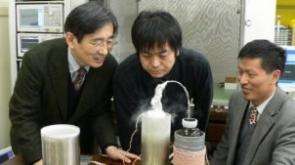New technique for easily identifying explosives in luggage

Scientists in Japan have developed a new technique for sensing explosives in luggage and landmines. The paper, published today in the Institute of Physics journal Superconductor Science and Technology describes how radio waves can be used to identify specific explosives, such as TNT. The new method could be used in future to screen baggage at airports.
The new technique has advantages over traditional methods of detection: unlike x-rays that are currently used in airport security, it can distinguish between different types of white powder from flour and salt to drugs and explosives. It can also be used to detect landmines, an advance on the traditional method of using a metal detector which cannot distinguish between bits of metal in the ground and an actual mine.
Professor Hideo Itozaki, one of the authors of the paper at Osaka University said: “Until now it has been very difficult to detect specific explosives such as TNT because they contain atoms of nitrogen that vibrate at very low frequencies.
The natural frequency at which the nucleus of an atom vibrates at is called its resonant frequency and the lower this is, the harder it is to detect what atoms are present in a molecule which in turn makes it harder to define what the molecule or substance is.”
The technique relies on nitrogen nuclear quadrupole resonance (NQR) which detects atoms of nitrogen (an element found in many explosives, including TNT) in different positions in a molecule. For example an atom of nitrogen attached to a carbon atom will have a different resonance to one attached to an oxygen atom. Because the molecular structure of each explosive is different, the resonant frequency will be different.
Professor Itozaki continued: “We have successfully developed a machine that can pick up very low resonant frequencies by using a SQUID (superconducting quantum interference device). The SQUID operates at a temperature of 77 Kelvin (minus 196 degrees centigrade) which we achieve by using liquid nitrogen. This will not hinder the equipment from being used in places such as airports as liquid nitrogen is becoming much easier to deal with and is already routinely used in hospitals and laboratories.”
Source: Institute of Physics





















